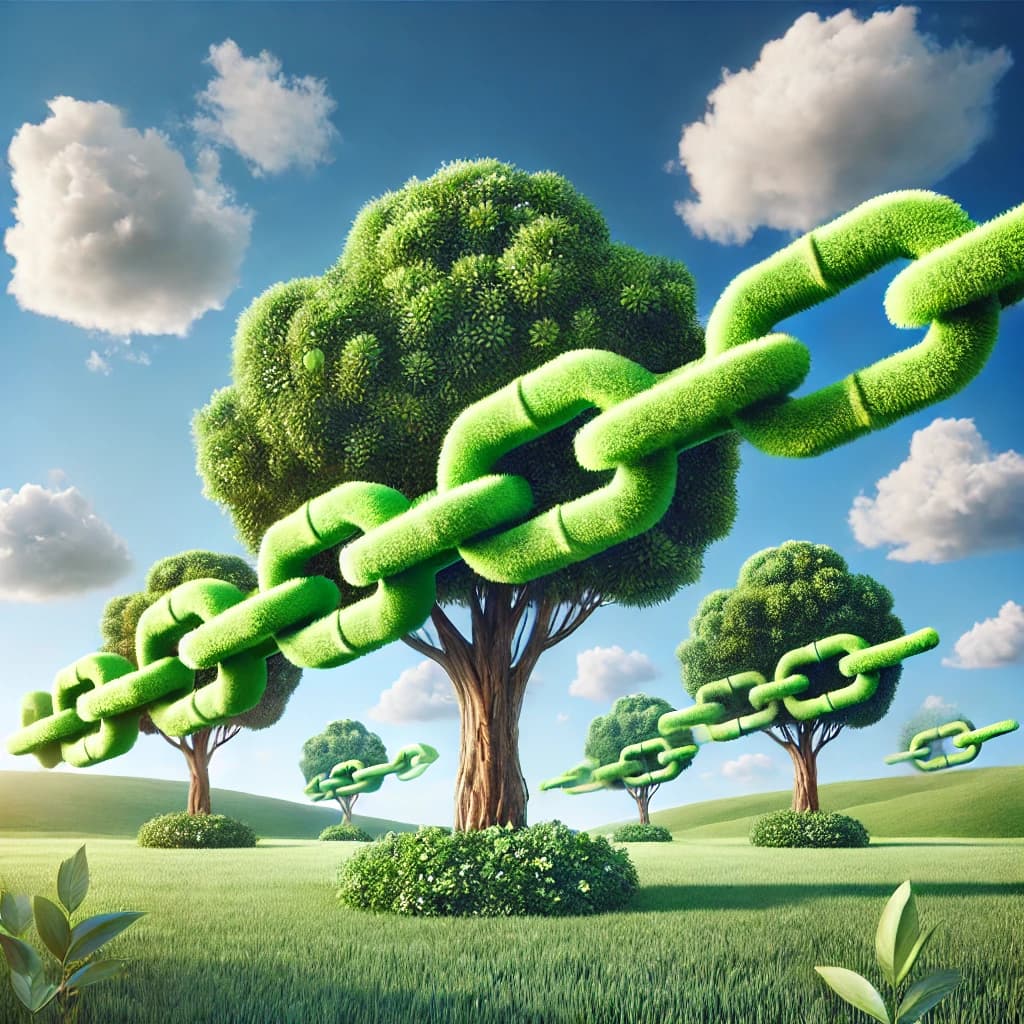How to Build a Sustainable Supply Chain: A Beginner’s Guide
Sustainability is no longer optional—it's essential. Building a sustainable supply chain means balancing environmental stewardship, social responsibility, and economic viability to create a system that works for the planet and its people. From reducing carbon emissions to fostering community well-being and ensuring long-term profitability, sustainable supply chains are the future of business. This beginner’s guide explores actionable strategies to transform your supply chain into a force for good. Discover how to leverage cutting-edge technologies like AI and blockchain, build strategic partnerships, and implement incremental changes that lead to significant impact. Whether you're sourcing raw materials or delivering finished products, every decision you make shapes a more sustainable future. The journey starts here. Learn how to align your supply chain with sustainability goals, adapt to new challenges, and unlock the potential for innovation and growth. Together, we can create resilient, regenerative systems that benefit everyone.

200+ buyers trust Torg for sourcing

Exploring Sustainable Suppliers

The understanding of supply chains has transformed in recent years. Gone are the days when success was measured solely by efficiency and profit margins. Today, we're witnessing a profound shift toward a more holistic approach that mirrors the complexity and interconnectedness of natural ecosystems.
Think about your last meal. Each ingredient traveled a unique journey, touching countless lives along the way. From the farmer who planted the seeds to the truck driver who transported the harvest, from the warehouse worker who managed inventory to the store clerk who stocked the shelves – every step in this journey presents an opportunity to make choices that ripple far beyond the immediate transaction.
At its heart, a sustainable supply chain operates as a living, breathing network that nurtures both people and the planet. It's like a carefully orchestrated dance where every participant moves in harmony with others, creating value while preserving resources for future generations. When we examine successful examples, we find they share three fundamental pillars that work in concert to create lasting positive impact.
The first pillar, environmental stewardship, demands that we fundamentally rethink our relationship with nature. Environmental stewardship in sustainable supply chains involves adopting practices that minimize ecological impact, such as reducing carbon emissions, conserving water, and supporting biodiversity throughout the production and distribution process. A shining example of this is Whole Foods. Whole Foods partners with the Marine Stewardship Council (MSC) to provide certified sustainable seafood, supporting responsible fishing practices that protect fish populations for future generations. This approach doesn't just protect the environment – it enriches it.
Social responsibility, the second pillar, recognizes that the strength of a supply chain lies in its people. Social responsibility involves initiatives that go beyond basic fair labor practices to actively invest in community development. Coca-Cola works with local communities in its sourcing regions to promote education, healthcare, and economic development. The company has partnered with nonprofits to improve access to clean water, enhance women’s empowerment, and support local agriculture.
The third pillar, economic viability, demonstrates that sustainability and profitability aren't mutually exclusive – they're mutually reinforcing. Forward-thinking companies are discovering that sustainable practices often lead to significant cost savings and new revenue opportunities. Case in point, the Danone’s Regenerative Agriculture Program. This program empowers farmers to adopt innovative practices like crop rotation, cover cropping, and reduced tillage. These methods not only improve soil health and boost yields but also reduce reliance on costly synthetic inputs. By fostering long-term economic resilience for farmers and ensuring a consistent, high-quality supply of ingredients, Danone is creating a win-win scenario that supports both profitability and sustainability.
The Need for Sustainable Supply Chains
The need for sustainable supply chains has reached a critical juncture. Global climate change continues to disrupt traditional agricultural patterns and crop yields, while resource scarcity intensifies across regions. In 2024, extreme and unpredictable weather led to significant agricultural crises globally. In France, excessive rainfall resulted in waterlogged fields and a 30-40% reduction in winter crop production. Similarly, Brazil faced both droughts and floods, and the USA experienced crop destruction from hurricanes, highlighting the global impact of climate change on agriculture. Meanwhile, persistent social inequities threaten the stability of global food systems. While these challenges demand urgent attention, they also create unprecedented opportunities for innovation and positive transformation.
Technological advances offer promising solutions for accelerating the transition to sustainable supply chains. Blockchain technology enables enhanced transparency and traceability throughout the supply network. Artificial intelligence systems optimize resource utilization and minimize waste, while IoT sensors provide precise monitoring of environmental conditions to ensure optimal growing conditions. AI-driven precision agriculture methods have the potential to boost crop yields by as much as 30% while cutting water consumption by 20-50%, enhancing resource efficiency and significantly reducing waste. However, technology serves only as an enabler – successful implementation requires an unwavering commitment to sustainability principles and a fundamental reimagining of traditional business models.
Creating truly sustainable supply chains demands cross-sector and cross-border collaboration. This transformation requires looking beyond short-term financial metrics to consider long-term generational impact. Success depends on active participation from all stakeholders – from business leaders making strategic decisions to consumers making daily purchasing choices.
While the path to sustainability presents complexities and challenges, its necessity is undeniable. Through collective commitment to sustainable principles and practices, organizations can build food supply chains that simultaneously nourish communities and protect the planet, fostering a more equitable and sustainable future for all.
Building a Sustainable Supply Chain: Key Principles and Practices

Today's challenge isn't simply about moving goods from point A to point B more efficiently – it's about reimagining entire business ecosystems to create lasting positive change. This journey of transformation, while complex, offers unprecedented opportunities for innovation and impact.
The Foundation: Understanding Your Supply Chain DNA
Think of your supply chain as a living organism, with countless interconnected parts working in harmony. Just as a doctor must understand human anatomy before treating a patient, businesses must develop an intimate understanding of their supply chain's structure before implementing meaningful changes. This goes far beyond creating a simple supplier list or logistics flowchart.
True, effective supply chain mapping requires a detective's attention to detail combined with a scientist's analytical approach. Every connection point, every transaction, every relationship becomes a vital piece of evidence in understanding your operation's true impact. This means tracking not just the obvious elements – like direct suppliers and immediate customers – but also understanding the deeper layers of influence your business has on communities, ecosystems, and economies.
Consider, for example, a seemingly straightforward product like coffee. A comprehensive supply chain map would include not just the farms where beans are grown, but also details about local water usage, community labor practices, transportation networks, processing facilities, packaging suppliers, and distribution partners. Each of these elements represents both a potential impact point and an opportunity for positive change.
The Power of Progressive Implementation
One of the most common pitfalls in sustainability initiatives is the tendency to aim for perfection from the start. This all-or-nothing mindset often leads to paralysis, preventing organizations from taking even the first steps toward meaningful change. Instead, successful transformation typically follows a more measured, strategic approach.
Think of it like climbing a mountain. While the summit might be your ultimate goal, you need to establish base camps along the way – stable positions from which you can plan your next moves and adjust to changing conditions. Each small victory becomes a foundation for larger achievements.
For instance, a food distributor might begin by focusing on reducing packaging waste in just one product line. This focused initiative allows them to test new approaches, measure results, and build internal support for broader sustainability efforts. The insights gained from this single project can then inform more ambitious initiatives across the organization.
Building Strategic Partnerships for Sustainability
The most successful sustainable supply chains are built on a foundation of strong, values-aligned partnerships. This goes far beyond traditional vendor relationships – it's about creating a network of organizations united by a shared commitment to positive impact.
When selecting suppliers, the modern business leader must look beyond the traditional metrics of price, quality, and reliability. Today's evaluation criteria should include:
- Demonstrated commitment to environmental stewardship
- Strong social responsibility practices
- Transparency in operations and reporting
- Innovation in sustainable practices
- Willingness to collaborate on improvement initiatives
These partnerships should be viewed as long-term investments rather than transactional relationships. Regular audits and assessments become opportunities for collaborative learning and improvement, not just compliance checks.
Leveraging Technology for Transformation
The role of technology in sustainable supply chain management cannot be overstated, but it's important to approach it strategically. Modern tools and platforms offer unprecedented capabilities for tracking, analyzing, and optimizing supply chain operations.
Blockchain technology, for instance, has emerged as a powerful tool for ensuring transparency and traceability. Imagine being able to trace a product's journey from source to shelf with absolute certainty, verifying sustainability claims at every step. This level of transparency not only builds trust with consumers but also helps identify opportunities for improvement.
Artificial intelligence and machine learning are revolutionizing how we approach resource optimization. These technologies can predict demand patterns, optimize routing, and identify waste reduction opportunities with remarkable accuracy. The Internet of Things (IoT) provides real-time monitoring capabilities that were unimaginable just a few years ago.
The Private Label Opportunity
Creating a private label brand represents a unique opportunity to exercise greater control over your supply chain sustainability efforts. This approach allows organizations to build sustainability into their products from the ground up, rather than trying to retrofit existing supply chains.
When developing a private label strategy, consider:
This level of control enables organizations to create products that truly embody their sustainability values while potentially creating new revenue streams.
- Direct Relationships with Primary Producers: Establishing direct connections with producers enables better oversight of sourcing practices and ensures alignment with sustainability goals.
- Custom Packaging Solutions that Minimize Waste: Consumer goods manufacturers are adopting sustainable packaging solutions made from materials such as peanuts, seaweed, eco-friendly textiles, cornstarch, mushrooms, recycled plastics, and more. Designing packaging that reduces material usage and is recyclable or biodegradable can significantly lessen environmental impact.
- Innovative Product Formulations that Reduce Environmental Impact: Developing products with sustainable ingredients and processes can lower carbon footprints and appeal to eco-conscious consumers.
- Complete Transparency in Sourcing and Production: Providing clear information about sourcing and manufacturing processes builds consumer trust and demonstrates commitment to sustainability.
- Strong Storytelling Opportunities Around Sustainability Initiatives: Effectively communicating sustainability efforts can enhance brand loyalty and attract customers who value ethical practices.
Overcoming Mental Barriers to Change
The psychological aspects of supply chain transformation often prove more challenging than the technical ones. I've found that success requires addressing both the rational and emotional elements of change management.
Leaders must work to create an organizational culture that embraces experimentation and views "failures" as learning opportunities. This cultural transformation requires celebrating small wins and incremental progress, while creating safe spaces for innovation and experimentation. Organizations should foster cross-functional collaboration, provide regular training and education opportunities, and maintain open communication about sustainability goals and progress. Through these combined efforts, companies can build a resilient culture that supports continuous improvement and sustainable innovation.
The Continuous Evolution of Sustainable Practice
Sustainability isn't a destination – it's an ongoing journey of adaptation and improvement. As our understanding of environmental and social impacts evolves, so too must our approaches to supply chain management.
This means staying informed about:
- Emerging sustainability technologies and practices
- Changes in consumer expectations and behaviors
- New regulatory requirements and standards
- Developments in climate science and environmental impact assessment
- Innovations in sustainable materials and processes
How to Build Your Sustainability Framework
Success in sustainable supply chain transformation requires a comprehensive framework that includes:
Strategic Planning:
- Clear, measurable sustainability goals
- Detailed implementation timelines
- Resource allocation plans
- Risk assessment and mitigation strategies
- Performance monitoring systems
Stakeholder Engagement:
- Regular communication with suppliers and partners
- Employee training and development programs
- Customer education initiatives
- Community outreach efforts
- Investor relations strategies
Measurement and Reporting:
- Comprehensive impact assessment protocols
- Regular sustainability audits
- Transparent reporting mechanisms
- Continuous improvement processes
- Stakeholder feedback systems
As we look ahead, the importance of sustainable supply chain management will only grow. Climate change, resource scarcity, and social equity concerns are reshaping the business landscape. Organizations that proactively embrace sustainability will be better positioned to thrive in this evolving environment.
The future of sustainable supply chains will likely include:
- Greater integration of circular economy principles
- Increased use of renewable energy and materials
- More sophisticated tracking and verification systems
- Stronger emphasis on social impact measurement
- Enhanced collaboration across industry sectors
Remember that every step toward sustainability, no matter how small, contributes to a larger transformation. By approaching supply chain sustainability with patience, determination, and strategic thinking, organizations can create lasting positive impact while building more resilient and successful businesses.
The journey toward supply chain sustainability is complex and challenging, but it's also one of the most important undertakings any organization can pursue. By combining strategic thinking, technological innovation, and genuine commitment to positive change, we can create supply chains that not only serve business needs but also contribute to a more sustainable and equitable world.
Reimagining Food Supply Chains: A Path to a Better Tomorrow

The transformation of supply chains into sustainable, regenerative systems represents one of the most significant opportunities of our time. As we've explored throughout this discussion, this isn't just about implementing new technologies or adjusting operational metrics – it's about fundamentally reimagining how businesses can create value while nurturing both people and the planet.
The challenges we face are substantial, from adapting to climate change to addressing deep-rooted social inequities. Yet within these challenges lie unprecedented opportunities for innovation, collaboration, and positive impact. Every organization, regardless of size or sector, has the potential to contribute to this transformation.
Success in this journey requires a delicate balance of bold vision and practical action, of short-term progress and long-term commitment. It demands that we think systemically while acting specifically, understanding that even small changes can cascade through our interconnected supply networks to create meaningful impact.
One thing is clear: the organizations that thrive will be those that embrace sustainability not as a compliance requirement or marketing strategy, but as a core driver of innovation and value creation. They will be the ones that recognize that true sustainability isn't about maintaining the status quo – it's about creating regenerative systems that improve conditions for all stakeholders.
The path forward requires courage, creativity, and unwavering commitment. It demands that we challenge our assumptions, embrace new ways of thinking, and remain open to continuous learning and adaptation. Most importantly, it requires that we recognize this isn't just a business imperative – it's our collective responsibility to future generations.
Together, we can build supply chains that don't just minimize harm but actively create positive impact. The journey may be complex, but the destination is clear: a world where business success and sustainability are inseparable, where prosperity is shared, and where every link in the supply chain contributes to a healthier, more equitable future for all.
Request a Bulk Order Quote
Simple ordering, transparent pricing, delivered straight to your door

